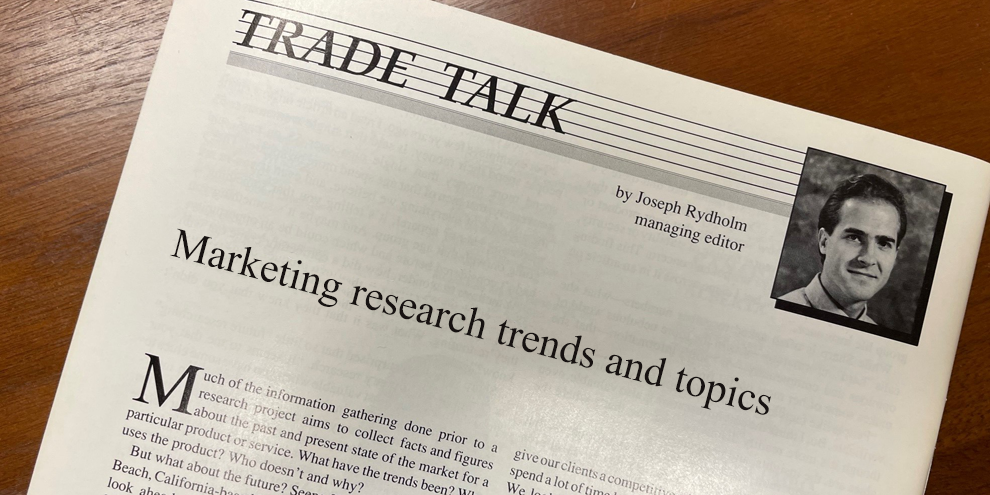Most of the research related books reviewed in our pages over the years have dealt with a specific aspect of marketing research - focus groups, psychographics, demographics - rather than the process as a whole. So I was happy when a copy of the new book "State of The Art Marketing Research" crossed my desk. I think it fills a void in research literature by providing a practical, up-to-date look at the research process.
Authors Al Blankenship and George Breen have drawn on their years of experience in marketing and research to cover the process from project design, testing, fielding, tabulation and analysis and presentation. The dust jacket notes indicate that Blankenship - professor emeritus, Bowling Green State University - worked for 26 years in practical research at ad agencies, client companies and research firms. Breen is a retired professor of marketing at Miami University. Among other positions, he served as director of marketing research at The Stanley Works in New Britain, Conn.
Their collective experience and their candid admissions of how they learned from mistakes lend the book an authentic, experienced-based feel.
The authors state that the book is aimed at the two "partners" in the research process - marketers and researchers - and also at top management. As this quote from the preface shows, the emphasis is on the practical: "We recreate as closely as possible real-life research situations. We take the student step by step through the key research concepts, but we omit much of the theoretical background... We stress applications and talk about specific sources of services, facilities, and specialized programs than can help researchers in on-the-job situations. Throughout, we are writing for the doers - those faced with marketing decisions."
All stages of research
With that in mind, they spend the book's nearly 600 pages covering all of the stages of the research process - in brief in early, overview chapters, and then in specific in later pages. Some of the topics covered include: how to decide if research is necessary and what approach to use; how to determine if an outside research firm would be helpful; how to choose between mail, phone, personal interviews, omnibus, etc.; how to develop a questionnaire; and a lengthy section on that most popular of research methods, the focus group.
Along with the emphasis on practicality, another idea running through the book is the value of information and cooperation. That is, making sure, when possible, that everyone who will use or benefit from a research project is involved and informed early on. This makes the research more effective because it answers the questions people want asked and it improves the likelihood that the validity of the research isn't questioned when the results arrive.
Since the book is so large and meant for a broad audience there are sections that some readers will skim through. Each chapter begins with a summary of its contents to make skimming easier. A few chapters feel padded but for the most part the authors know when to be concise and when to explain at length.
Consumer guide
Research firms may find it a handy resource to educate potential clients on the strengths and weaknesses of a particular approach. Research buyers will see its value as a "consumer guide" to research services that gives the reader several questions to ponder when choosing among research techniques and/or providers.
Also helpful to both in-house and outside researchers is the chapter on presenting research results. It gives valuable, common-sense suggestions on how to shape your presentation to meet the needs (and attention spans) of your audience: "Presenters will succeed if they have planned their research well and speak to the desires of their listeners. Presenters who forget that they are talking to Joe the package designer, to Mary who writes ad copy, and to the company president who is measured by the rise and fall of sales and profits have failed to do their job. A good presentation should be a mutual interplay of interest between the speaker and audience."
High-tech
The "state of the art" in the book's title is an acknowledgment that as computers and other technology have increased the capabilities of researchers so have they increased the expectations of the people who use the information researchers gather. Since all of that high-tech stuff is out there, the reasoning goes, researchers should be able to function with high-tech speed and precision.
The real world isn't always like that. So while Blankenship and Breen include passages on new techniques and technology and acknowledge their benefits, they show that old-fashioned careful planning and communication - between research vendor and client, between the in-house researcher and his or her "clients" - are two of the most important components of successful research.
"State of the Art Marketing Research" by A.B. Blankenship and George E. Breen (hardcover, 580 pp., $44.95) is published by NTC Business Books, 4255 West Touhy Ave., Lincolnwood, IL 60646-1975. Phone 800-323-4900.
